Prompt: Describe the Color Yellow to Someone Blind From Birth

[This poem is a response to the NaPoWriMo (National Poetry Writing Month) prompt.]

[This poem is a response to the NaPoWriMo (National Poetry Writing Month) prompt.]
I was talking about pets the other day with some of my friends. One of them has recently adopted a dog and the other one is also planning on getting one. All of us know a dog lover or two. All of us know a downward dog lover or two too (#yogahumor)!
In ‘Beyond Asanas‘ the first chapter is about the downward dog pose. When researching this posture I looked at dog-lore from different cultures. My goal was also to unearth dog-related stories in our mythology. And sure enough – I found a few stories – two of which have made it into this chapter. In one story a dog helps Lord Indra and in another story a dog is granted admission into heaven after the battle of Kurukshetra.
The Downward Dog is a challenging posture. The most common challenge I see with students is the inability to lengthen the spine. Many beginners are in a hurry to place the heels on the floor, and this compromises the form of the lower back.
How To:

It’s a good idea to start in Vajrasana because your legs are together – which is how you want them to be in the final posture too.
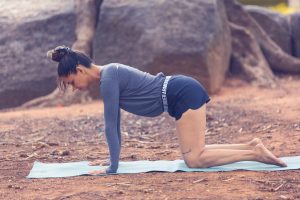
In this position position you need to make sure that your wrists are right under should shoulders. And here you can also separate your legs about hip width distance, making sure that the ankles and knees are in one line.

Notice the length in the spine. Things you must watch out for: allowing the shoulders to sag down close to the ears, a curve in the thoracic and lumbar spine, and bent knees. Watch this video to learn how to correct these alignment issues.
You can use props such as a wall, blocks and a rope to help you in aligning the posture. I’ve written a few helpful hits about how to improve this posture in ‘Beyond Asanas: The Myths and Legends Behind Yogic Postures’. Those of you who follow me on YouTube may remember this video I made in 2016. It’s a great video for beginners, because of the detailed explanation of how to get into the posture. Do check it out – it will surely help.
I’ve listed out at least 10 benefits of this asana in the book. However, there are contraindications as well, and those have also been described in ‘Beyond Asanas’. Pick up your copy today.
I’ve never had a dog, but I’m not impervious to their charms. If you’ve been following this blog, you’ve met Aston. He makes my time in Pune a little more fun, a little less lonely.
New patients come to SVYASA on Fridays. When I arrived last Friday I didn’t get a chance to see the in-patient process as I was registering myself as an intern. Today I saw patients coming in and consulting with the doctors. Doctors then refer them to the appropriate department where their vital statistics are taken and files created for each patient. The hospital at SVYASA doesn’t have your typical hospital feel. At any given time you have interns from other institutes and around the world and resident college students observing the processes and method of treatment. The mood is light and happy instead of somber and grievous.
It was interesting to observe the behavior of new patients today. Most described themselves as ‘no problems, just a little acidity all the time’ or ‘nothing as such, just from time to time some depression’ and ‘i have no issues as such, just a little bit of weight problem is there’…and so on and so forth. In a way there is lots of optimism, but somewhere I wonder, is there also denial? If you don’t truly believe that you need a change, regarding your health or anything else in life, will you put 100% into making that change? The only time I’ve been able to bring about change is when I’ve accepted that I need or want a change more than I want the status quo. It’s important to face your issues head on, rather than trivializing them.
Also tonight is my last night here! I can’t believe it’s been one week already and I’m really looking forward to getting back home, to my classes and daily practice. I still remember Day 1.
In other news – my Liguria yoga retreat is on track and we’re excited to announce that seats are filling up fast! Below is a snapshot of what happened in the last retreat. The next one is going to be bigger and better.

Meditating (or pretending to) somewhere in the hills of Kotagiri. How I long to be back there meditating and breathing the fresh air. pc: Animesh Jain
Today I was posted to perhaps the most interesting department. The Gastroenterology department.
And I’ve finally made a friend!!! She’s doing a BSc. here and is also employed as an Ayurvedic therapist. So she studies and works at SVYASA. She’s become my one stop shop for any queries, and it’s nice to have a friend who knows her way around!
Since the full time therapists are always too busy to answer my questions (and there are always so many questions), I usually end up discussing my queries with Aishwarya. I usually observe silently as patients describe their symptoms to the doctors. The doctors make notes in the files.
Later I pick Aishwarya’s brain.
The symptoms that most patients report are things like bloating and indigestion. If ignored or left untreated these can lead to more serious issues such as chronic constipation, IBS and ulcers. At SVYASA the first line of treatment is to put these patients on an Ayurvedic diet and have them attend various yoga and meditation sessions.
“But do you think the answer to a medical problem so prevalent is as simple as changing the diet and moving a bit more?” I asked her.
Apparently it is. Patients who come in with even severe cases of gastritis report a marked improvement after just a week on the SVYASA routine. Here their food and meal times are regulated. Although the quantity of food can’t be controlled but what the patients (and us) eat is very very simple. It is basically rice, roti, dal, a sabji and buttermilk. Not once has the food been too spicy or too salty. There’s never dessert. Fruit isn’t on the menu and in the evenings they serve a dairy-based malt instead of coffee/tea. We end up eating at the same time every day, which promotes healthy digestion.
We exchanged some personal anecdotes as well. She told me about how she was overweight before she came to SVYASA and her diet underwent a sea-change during the time she’s been here (the last 2 years). I described my weight-loss journey as well and how it was a solid asana practice and a supremely controlled diet that helped me. Aishwarya’s diet is similar to an Ayurvedic diet. Below are a few of the guidelines she follows:
. no sugar
. no milk
. no coffee or tea
. no refined flour, refined rice, refined oil
I didn’t ask her about alcohol but I’m sure that’s also a no. Also, she feels that the food served in the mess isn’t wholesome and so she also makes a malt for herself every once in a while. It’s a powder containing multi grains which she mixes with water and jaggery. Served hot.
Along with what we eat it’s important to eat at the same time every day. It builds regularity in digestion. Erratic meal timings lead to erratic digestion. Erratic digestion gives rise to every single condition treated in the Gastroenterology ward.
Sleep and stress are two factors that simply can’t be overlooked when it comes to digestion. Insufficient or disturbed sleep interferes with the secretion of digestive enzymes which is why you feel sluggish when you’re sleep deprived. It’s the same story with stress. Chronic stress inhibits the secretion of digestive enzymes. Chronic stress will also interfere with the secretion of melatonin, which will in turn lead to sleeplessness, which will cause digestive disorders…and the viscous cycle continues.
The only way to break this cycle is to wake up one day and commit to living better, one decision at a time.
Yesterday was my first day at the Department for Metabolic Disorders. The person in charge was short, squat and had a very aggressive look to him. His name is Shan and I decided to stay clear out of his way.
Class was almost over. All yoga sessions here are similar. Today many supine and prone asanas were included in the routine because we were dealing with metabolic conditions. I was surreptitiously checking the time when all of a sudden I realized Shan was talking to me. “Do you know how to do DRT?” he asked me with an evil glint in his eye.
‘No…uh yes!’ I stammered.
‘Yes or no?’
“I know what DRT is and I’ve attended sessions also but I’ve never conducted it,” I told him, finally getting a hold of myself.
“Hmmm….meet me in my office after class.” He looked at the other intern pointedly, indicating that she was also expected.
“What course are you doing here,” he asked in his office.
“MSc,” I said. “But distance,” I added, hoping that was some sort of justification for not knowing the Deep Relaxation Technique, a meditation technique patented by SVYASA.
“OK, first – tomorrow you both will bring your mats,” he said. “You guys must also participate in the classes. Seeing you the patients feel motivated to move.”
“Yes sir,” we both said in unison.
“Also tomorrow we don’t have class, we have kriyas. You guys be there by 6 am and help the patients.”
I saw this as my chance to practice kiryas under supervision, and quickly seized it. “I can do jal neti, but sutra neti and vamana dhouti are really difficult for me.”
“Then I will teach you. Do you know LSP?”
“Heard of it but I’ve never done it. But I want to!”
I reached the kriya block with my neti kit and my nerves in a bundle. It had been years since I’d done the sutra neti and vamana dhouti. And I was hoping LSP – Laghu Shankh Prakshalana wasn’t going to leave me with the runs.
“Sir, this sutra isn’t going into my nose,” I said as I worked the rubber catheter into my nostril. But he kept encouraging me and eventually the catheter was in the back of my throat. In fact, this morning (because he threatened that he would do it himself) I was able to reach into my throat and pull out the other end of the catheter. This was the second time in my life that I was able to do this.
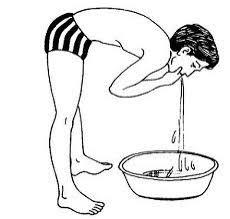
Vamana Dhouti
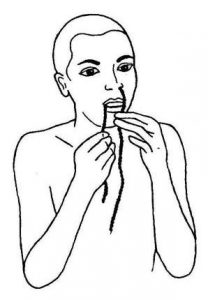
Sutra neti. I wish I had images of me doing the kriyas, but I was so busy doing them that I forgot to document them!
During vamana dhouti he told me about the importance and relevance of cleansing practices. “If you’re a regular practitioner you should do this once a week. Your asanas will improve. These practices are important.” I tried to re-gurgitate the water without resorting to pushing my fingers down my throat. In the end, it was my fingers that did the trick.
LSP is a technique to clear the entire digestive system. I drank 4 glasses of salt water and then did the basic stretching exercises. Then drank another 4 glasses and did them again. By the time I was back in my room I was ready to exploded in the thunderbox. It took a long long time. The water makes it way through the entire digestive system, bringing along toxins. You know your digestive system is clean when the water coming out of you is clear. As he said, “The water should look like your urine. If it doesn’t you have to go again.” It took me all of one hour, but I’m happy to report that my first time at LSP was good. I’m going to continue doing this practice at home too.
As I got the final sign-off from him, I noticed that his smile didn’t look evil or intimidating anymore. Note to self: the greatest lessons sometimes come from the most unexpected sources.

Swamy Vivekananda is arguably one of the most popular spiritual leaders of India. He was born on Jan 12, 1863 to wealthy parents. He was christened Narendranath. Born to priviledge he was also well educated and had a liberal upbriging. As a young adult the question of God and the Supreme Being fascinated him, and he tried finding answers to his spritual crisis with reason and logic. The quest for an answer took him to many religious teachers and masters. He finally found what he was looking for in Sri Ramakrishna, another prominent spiritual master at the time. This resulted in a deep spiritual bond and Narendranath became Swamy Vivekananda.
In 1893 Swamy Vivekananda represented India in the World Parliament of Religions held in Chicago. His lecture was about India, Hinduism and Sri Ramakrishna’s philosophies. His speech drew a lot of interest and he spent the next two and half years in America, and eventually established the Vedanta Society of New York.
Despite a deep respect and love for Hinduism, Swamy Vivekananda thought of his countrymen first which is why he is considered to be an early nationalist.
This institute is named after him because he represents a scientific approach to Indian culture. SVYASA endeavors to explain the expansiveness of Indian culture and attempts to cultivate a love for the country among the students. For this reason we have bhajan classes and talks, students learn desh-bhakti songs as well, the national anthem and the national song are a daily affair and discourses are held on important lessons from the Gita. I know it sounds a lot, and maybe a tad bit too Hindutva for many of you. But…it’s not that bad!
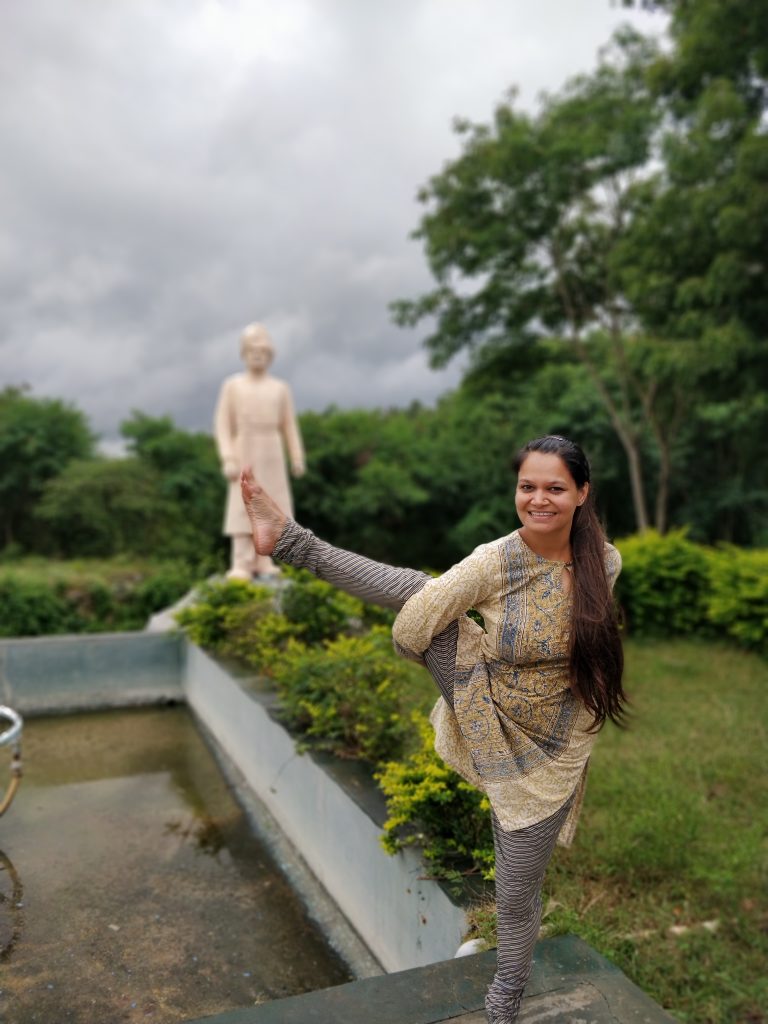
I’m dog-tired as I write this. Here at SVYASA they are very particular about routine. The first session of the day is at 5.30 am.
A chilly wind was blowing when I stepped out to make my way to the Sampurna Hall at 5.15 am. With uncanny foresight, I’ve brought along the warmest stole I have, along with warm sweaters. I reached the hall while it was still dark outside. The hall’s dim lighting made me want to go back to sleep. Surprisingly, not many people attended the session, and I found a space to sit quite easily.
As part of my Master’s program in Yoga Therapy, I’m required to intern for a total of 16 days at Arogyadhma – the hospital at SVYASA (Swamy Vivekananda Yoga Anusandhana Samsthana). I decided when I registered for the course that I would try to complete at least 8 days of the internship in 2019, to ensure that work doesn’t pile up.
In 2011, when I was a student of the YIC (Yoga Instructor Course) I once got a bad attack of allergies. I started sneezing uncontrollably, my eyes were watering and I could barely open my eyes. It was similar to my mother’s plight during Cherry Blossom season when we lived in the US. Although I was fine in the US, I had suffered from terrible allergies from the time I’d moved to Bangalore – the reason for that could be an entire medical case study. Anyways, the allergies became an yearly affair, and I’d somehow managed to live through the season. But this time the attack was the worst ever. I was (and still am) the kind that never takes medicine – unless my life depends on it. And that day it did.
I walked into the resident doctor’s office. ‘Help me,’ I squeaked, unable to even get a good look at who I was speaking to. The doctor made a sympathetic sound and said, ‘Take a Crocin!’
‘But I don’t take medicine,” I protested feebly. “I’m looking for a cure!”
‘OK then take a quarter of that Crocin to suppress the symptoms for now, and then do Jal Neti.’
It worked. Since then I’ve kept my allergies at bay just with the practice of Jal Neti. Theoretically, Jal Neti (nasal irrigation) should never be practiced during a bout of cold/allergies. However, in my experience Jal Neti can be used to prevent symptoms from getting worse. The first time I used Jal Neti (back in 2011), it was while I had a full blown allergy attack and I practiced it three times a day, and it helped more than anything else ever had.
Having experienced the efficacy of an alternative healing technique myself, I have a keen interest in alternative healing. Which is why I’m happy that a 16 day hospital internship is part of my Master’s program. The hospital here at SVYASA is called ‘Arogyadhama’ which is Sanskrit for ‘The Place Free of Disease.’ A combination of yoga, Ayurveda and allopathy techniques are used to treat various ailments here.
I’ve been allotted a hostel room – on the fourth floor, replete with an errant gecko in the bathroom, a swarm of ants, a few cobwebs, a grasshopper in the toilet which refuses to be flushed out and a family of monkeys. And I told them I wanted a room all to myself!
It will take a few days to settle in, and I look forward to a fruitful 8 days. I will be blogging daily from here – to give you insight into the kind of work I’m doing, the life of a yoga student, and general bits I learn about life here. Do check back in tomorrow evening for an account of my first day as an intern at a hospital for alternative therapy.
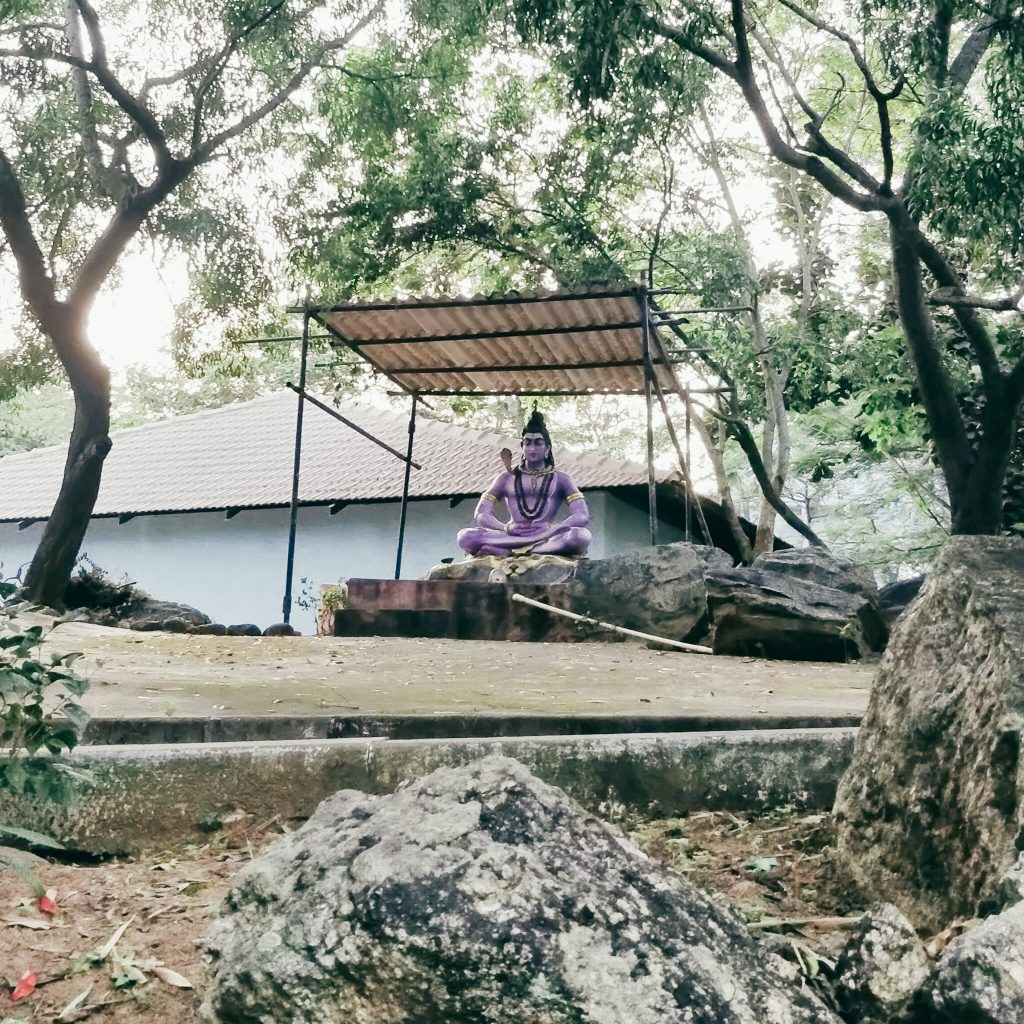
Just a purple Shiva meditating in the forest – a regular sight here at SVYASA.
My book ‘Beyond Asanas‘ was published this year on June 21st.
Many know that June 21st is also International Yoga Day, but many don’t know that PM Modi proposed Yoga Day to the United Nations in 2014 and in 2015 the Summer Solstice (longest day of the year) was declared World Yoga Day.
Below is a snippet from the PM’s speech to the United Nations:
Yoga is an invaluable gift of India’s ancient tradition. It embodies unity of mind and body; thought and action; restraint and fulfillment; harmony between man and nature; a holistic approach to health and well-being. It is not about exercise but to discover the sense of oneness with yourself, the world and the nature. By changing our lifestyle and creating consciousness, it can help in well being. Let us work towards adopting an International Yoga Day.
(Source: Wikipedia)
So when a friend’s mother suggested that I send the book to PM Modi, I thought it was a great idea. And I never expected to receive a response. But I did!!!
The world is becoming increasingly divisive, stressed, agitated. Yoga is the solution, for through the practice we connect to ourselves, and through ourselves we connect to others.
PS – not a grammar purist so found this letter incredibly cute ?.
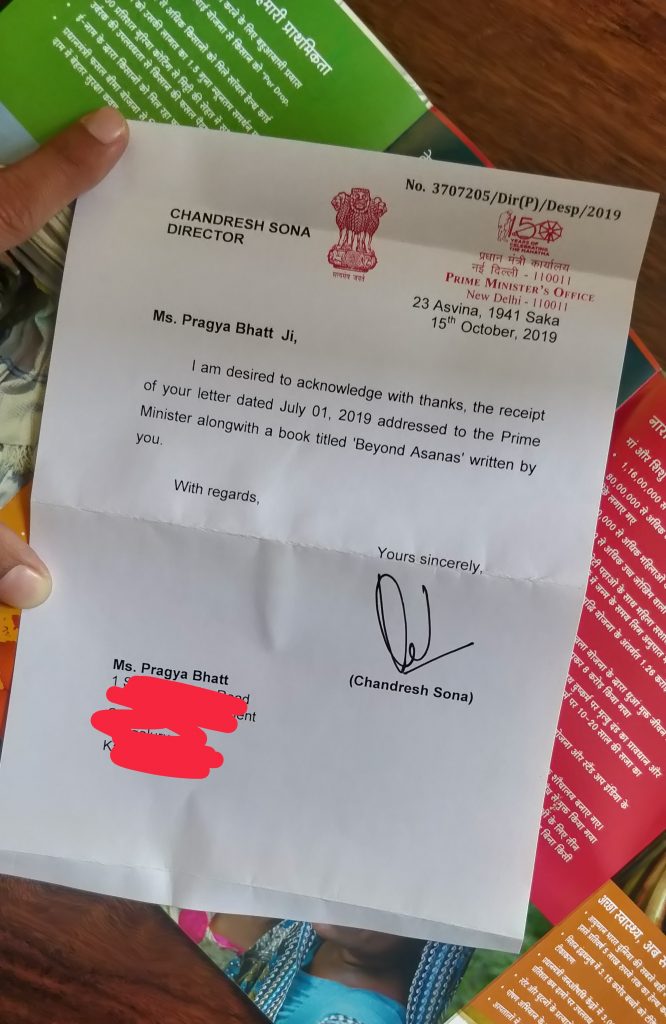
As many of you know, a friend of mine from my Infy days (2005-2007) visited me last weekend. We were sitting at The Thirteenth Floor, gazing out at the Bangalore skyline when she asked me, “Do you have a good life here? Are you happy?” Ever the optimist, I promptly said yes.
And later, I thought about my ‘good life’.
I live in a country where poverty, lack of basic human rights, illiteracy, unemployment, lack of healthcare and proper hygiene and much more is a reality for many. I have to only look out of the window of my air-conditioned car to see that reality plainly and starkly.
Maybe it’s because I didn’t grow up here, or because as an empath I can feel deeply, but this reality always tinges my gratitude. Being a ‘have’ or a ‘have-not’ is simply an accident of birth. And our lives will be shaped by what we do with the cards we’ve been dealt.
The holidays are when I get a breather. Maybe that’s why my mind starts to automatically take stock. Below are a few things I’ve been thinking of lately.
In a country where making ends meet can be a constant source of worry for most, I’ve been able to create a niche for myself in a place of my choosing because I’ve had the luxury of not having to worry about rent, utilities, organic veggies and well-fitted yoga pants.
At 37 and single, I rent an apartment in a nice neighborhood with no problems. I don’t have to contend with nosy neighbors interested in why I’m single or when I’m going to get married. No one cocks an eyebrow when I come home late and I don’t get long ‘settle down now’ lectures from aunties in my building. In a space dominated by the 9-5-vers, my largely bohemian lifestyle is accepted. A decade ago this would’ve been impossible.
I’m living in a country in which people are fueling the growth. We are demanding more from our leaders and our bosses, from our parents and our friends. We are choosing to get married later or not at all, and it is being accepted. We are choosing to use are expensive technical degrees to start small entrepreneurial ventures which we hope will make big impacts, and we are finding support. We are trading in the old definition of stability and finding purpose in new definitions.
These are pretty much the thoughts in my mind during this Diwali.
For those of you living in India, do you also find yourself thinking along these lines? Or am I an over thinker?
